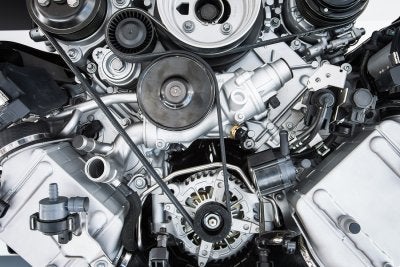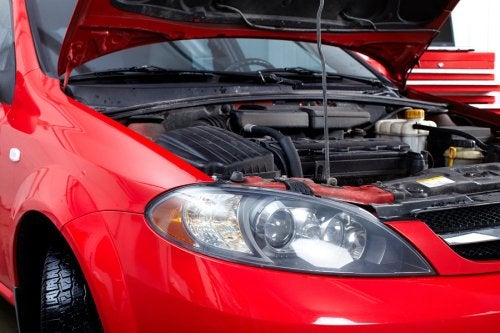-
What You Need to Know About Transmission Fluid Leaks
Transmission fluid is responsible for keeping this part of your car in safe operating condition whenever you hit the road. When you schedule transmission repair in Sacramento , your technicians will look for visible signs that your car’s transmission has sprung a leak. Leaking fluid can cause major damage to your automatic or manual transmission, so it is important to diagnose and repair this issue right away. Here’s a look at what every driver needs to know about car transmission fluid leaks:

Transmission leaks can be difficult to diagnose.
When you spot a bright red pool of liquid underneath your car, this is a clear indication that your vehicle is leaking transmission fluid. While you may be able to easily identify the fact that your transmission is leaking, pinpointing the cause of the issue can be much more difficult. The best way to diagnose this type of fluid leak is to bring your car to a dedicated automotive repair shop for servicing.
Transmission leaks can cause serious problems.
If your car has recently started to leak transmission fluid, you may be tempted to continue driving it until you have time to book a service appointment. However, leaks can wreak havoc on the performance and safety of your transmission. Waiting to repair your vehicle’s leak can cause your gears to grind together, and may eventually lead to a total transmission fluid failure.
Transmission leaks can be repaired.
While leaks are serious, you should not despair if you notice fluid leaking from your car’s transmission system. By bringing your car to a certified mechanic that specializes in transmission work, you will be able to fully address the issue. From repairing leaky seals to fixing gaps in the various parts of your transmission, your mechanic can provide you with the services needed to get your vehicle back up and running like normal. After your leak has been repaired, you may want to set up transmission fluid flushes at routine intervals.
-
Get the Answers to Your Questions About Pre-Purchase Inspections
If you are shopping for a luxurious German vehicle that is offered at a great price, you may want to think about buying a used car. To make sure that your used vehicle is in good mechanical condition, you should always set up a pre-purchase inspection before you finalize the sale. A German auto mechanic that offers pre-purchase inspections in Sacramento can review the performance and safety of your potential vehicle. Check out these answers to some commonly asked questions about the benefits of pre-purchase inspections.

Why should I schedule a pre-purchase inspection?
When you are considering buying a used car, you may be curious as to whether a vehicle check will be worth your time and effort. In fact, having your potential car looked over by a mechanic can save you significant time and money in the long run. If a major mechanical flaw is revealed during the inspection, you will know that it is a much better idea to pass on purchasing the vehicle.
What happens during a pre-purchase inspection?
There are several steps involved when your mechanic looks at a used car. Typically, he will start the process by using computer diagnostic equipment to check for any trouble codes that are being sent out by the vehicle’s computer. Next, he will look at the quality and condition of the engine, brakes, transmission, and tires. Once the car passes the multi-point inspection, it will get the seal of approval from your mechanic.
Who should perform my pre-purchase inspection?
If you already bring your car to a European auto mechanic, you can book your inspection at your regular automotive facility. For first-time German car buyers, it is important to find a mechanic that specializes in repairing your specific make of vehicle. A European auto repair facility that serves your local area will have the tools and knowledge needed to carefully inspect your vehicle. This will allow you to feel confident in your decision.
-
Is Your Transmission Failing?
Your car’s transmission transfers power from your vehicle’s engine to its wheels. In this video, you will learn some signs that your car is in need of transmission repair near Sacramento. When you start to notice that your transmission is acting funny, this could indicate that it is failing . If your transmission fluid is starting to smell burnt, this is another indicator that your car is having problems.
With services from a shop that specializes in transmission repair, you will be able to get your car back on the road in no time. From minor leaks to full rebuilds, your mechanic will have no problem providing you with the services that are required to return your transmission to a fully operational condition.
-
Intermediate Shaft Bearing Failure IMS Failure
Some of the most frequently asked questions about early water cooled Porsche boxer engines are, “how do I know when my IMS is failing,” “does my car have an IMS problem, and if so, do I need to worry about it?”. These are all good questions. I could try to explain this to you in technical mumbo jumbo, but you’d get about half way through it and turn the page. I’m going to do my best to explain it to you in layman’s terms based on my observations.
What is an intermediate shaft, you ask?
An intermediate shaft is used to transfer motion from one component to another, via chains. In this case, it is transferring motion from the crank shafts to the camshafts. It also keeps everything in time and rotating in unison, like the gears in a fine clock.
Early air cooled Porsche’s had a short intermediate shaft that is driven off of the front of the engine, transferring that motion to the cam shafts. Both camshafts are driven at the front of the engine. The shaft is supported by bearings that are lubricated by the engine’s oil system (Mezger Design).
With the introduction of the Boxster, Porsche went to a long shaft. This configuration drives 1 cam at the front of the engine and 1 cam at the back. It is supported at the front by an oil fed bearing and at the back by a sealed, self contained steel roller bearing. That roller bearing has it’s own lubricant that is meant to keep the bearing lubricated for the life of the vehicle.
Here is where the problem lies. Over time, the seals on the bearing fail, the lubricant that is meant to last the life of the engine escapes. Now there is no lubrication, and the friction destroys the steel bearing. This allows the the chains to become loose and come out of time. When the engine is out of time, pistons and valves “come into contact” (putting it mildly) with each other. Just like the gears in a clock, if they come out of alignment it will no longer keep time. Accept the consequences are more catastrophic with your engine, resulting in complete engine failure.
Which cars are affected?
All Boxsters from 1997 to 2008, Normally Aspirated 911’s 1999 to 2008, & Caymans 2006 to 2008.
996 & 997 Turbo engines are not affected by the IMS Failures. Their engine design is very similar to the air cooled engines (Mezger Design) & are not prone to failure.
What changed after 2008?
With the introduction of the 2009 models, Porsche redesigned or retro-designed their engines. They scrapped the long shaft design and returned to the original short shaft design. Bearings are lubricated by the engine’s oiling system, no longer rely on a self contained bearing.
Which cars have serviceable IMS Bearings?
From 1997 to 2004 all normally aspirated boxer engines have IMS’s that are serviceable. On the earlier cars, the most opportune time to replace them is during a clutch job, because in order to get to the IMS Bearing, the clutch & flywheel have to be removed. Unfortunately, on Tiptronic cars, there really is never an ideal time to do it. The transmission & flex plate will need to be removed. Later cars (2005 to 2008), require dismantling engine to replace the bearing. This is because the bearing can not be pulled through the case opening like the earlier cars. A boss prevents the bearing from being pulled out through the case opening.
How can I tell if my IMS Bearing is failing?
This can be difficult. Monitor oil leaks, especially from the bellhousing area. This could indicate that your bearing is or has failed. When bearing begins to wobble, oil will leak from the support shaft. You should have your oil filter inspected at every oil change. By cutting the end caps off, opening the filter up you can look between the pleats. If see any silvery metal in the pleats this could be a sign that your IMS is failing. The only problem with this method it is only a snapshot in time. Weeks or days later your bearing can start to fail, and you may have no idea. We have noticed that most failures occur with lower mileage cars, tiptronic cars, cars that are driven in lower rpm range. This is not to say high mileage cars or manuals are exempt from the problem, but it is a trend that we’ve noticed over time.
What else can I do to be proactive?
There are monitoring systems on the market. LN engineering (lnengineering.com) has developed an early warning system that can detect ferrous material in the oiling system. Once it detects the presence of material, it sets off a warning light. This allows you to shut the engine off, have it towed to a shop to perform an IMS Update hopefully in time. LN Engineering is at the forefront of IMS Bearing failure analyst & solutions. They currently have 2 retrofit options available. The first option is for single row or double row bearings. It is a Ceramic Ball bearing design. Ceramic bearings are harder, more durable than steel bearings. This is design is recommended to be replaced every 75,000 miles or 6 years. The second Option is a plain bearing that is oil fed, like the main & rod bearings in your engine. This setup is a more involved, requiring a new spin on oil filter, oil line installation & modification to the engine case. It is a bit more involved, but it’s also designed to last the life of the engine.
How to extend the life of your IMS?
First, DRIVE YOUR CAR! As stated earlier, the lower mileage vehicles seem to have the highest rates of failure. Second, drive your car like it was meant to be driven. Low rpm’s tend to be detrimental to the IMS. The analogy we use is, “you own a thoroughbred not a plough horse.” They are meant to be driven at the higher rpm range. We recommend keeping the rpm’s up above 2500 rpms. This may lower your fuel mileage, but if you’re concerned about fuel mileage, buy a hybrid. Lastly, ALWAYS do your routine oil changes. Splitting the recommended service interval in half, or changing your engine oil at least once a year allows us to keep an eye on debris in the filter, which is always beneficial.
So what can we take from all of this?
Earlier design had some inherent problems, but even then, the failure rate hovers around 10%. It is a bit of hit and miss whether your car will be affected or not. If you own an early car (1997 to 2004), it is a good idea to have your IMS updated, especially when performing any clutch work or anytime your transmission has to be removed. Have your oil filter inspected at every oil change & have your oil changed more frequently. If you drive your Porsche as a daily driver, we recommend splitting that interval at least in half. If it’s not driven as much have it changed once a year. Check for oil leaks noting where they are coming from. Finally, enjoy your Porsche! Drive your car, and by all means, drive it the way it was meant to be driven, Obey All Traffic Laws (wink wink), but keep the rpms up. SVR-PCA events, like tours and rallies, are a perfect way to stretch your Porsche’s legs. It may sound counterintuitive, but you’ll find the more you drive your Porsche the fewer problems you will have. Neglect and underuse are the enemies of all vehicles. Get out there drive and enjoy!
(This is an article by Nick Lettini of Frank’s Automotive for the local Porsche Club Monthly Publication) – https://svr-pcaor.org/wp/wp-content/Drifter/2017/201705.pdf
-
Why Should You Have A Brake Fluid Service?
We are often concerned with brake pad wear and overlook the condition of brake fluid. Brake fluid is a vital component of our brake system. It is responsible for transferring motion from our foot, through the pedal, and finally stop the wheels. Our brake systems are hydraulic and fluid is necessary to transfer that force from your foot to the wheels.
Why brake fluid and not some other fluid like water?
Brakes stop our cars using friction. A byproduct of friction is heat, and that heat exceeds 212° F, the boiling point of water. When a liquid boils, it changes from a liquid to a gas. Liquid is not compressible, that is why we use it in hydraulic systems. When you introduce a gas/air in a hydraulic system that system can no longer force that fluid in a singular direction with any efficiency. If you have had the unfortunate pleasure of driving a car with failing brakes, you may have experienced the pedal sinking to the floor or feeling spongy. That spongy feel is the air in the system being compressed. Brake fluid was created to raise that boiling point in excess of 440° F, not allowing the introduction of air into the system. Brake fluid also prevents corrosion in the brake system. It prevents electrolysis from corroding and etching the metals in the system. The damage created by electrolysis can ruin seals and damage components like,the master cylinders, brake calipers, hoses, anti lock brake pumps, and valves.
How does water get into brake fluid?
Brake fluid is hygroscopic, it absorbs water from the atmosphere and through pores in the rubber lines of the system. Wet and humid climates speed the process up. We test brake fluid using an electronic tester. It tests for voltage. If it tests 0.25 volts or above your brake fluid has higher than 2% water content. Anything 2% or above is excessive and it is recommended that you perform a brake fluid service.
How is a brake fluid service completed?
Different manufactures have different methods, but we will give you an overview of how it is done. The three things we are trying to eliminate are water, contaminants and air. We start off by drawing out the old fluid in the brake fluid reservoir. We pour fresh fluid into the reservoir and attach a pressure bleeder to the system. The pressure bleeder pressurizes brake fluid allowing it to be moved from the reservoir to each wheel. From there we go to each wheel and open up bleeder screws allowing the pressurized fluid to escape. We start with the wheel furthest from the reservoir and work are way to the closest. We allow the old fluid to flush out of the system, along with removing any trapped air bubbles.
How often and when should I have a brake fluid service?
Most manufacturers recommend servicing a brake system every 2 years. We check your brake fluid every time your vehicle comes in for a 45 Point Courtesy Inspection. It is one of the things we check for you at no charge. We go by what our testers tell us. If it tests below 2% and clear, there is no need to perform a service.
So remember, brake pads and rotors are an important part of the braking system. Brake fluid is the vital component to ensures your car will stop. Make sure your brake fluid is free of water, contaminants, and air bubbles, so you can stop you vehicle with confidence.
-
When & How Often Should I Change My Oil?
This is a good question. Today’s cars are usually filled with synthetic oils. Most automotive manufacturers have varying opinions on oil change intervals. They may recommend oil changes every 10,000 to 15,000 miles. The proper synthetic oils can last that long, and often do. A problem arises when your vehicle is burning and actually consuming oil. Most of us assume that when a car uses or burns oil nothing is left behind. The reality is, when it burns off a portion of that oil remains behind. Motor oil, as with any other liquid, will evaporate. When it evaporates or burns off a portion of that oil remains behind as carbon and sludge deposits. It is like frying something in a pan. You add clear oil and begin to heat it up. The oil gets hot and will start evaporate. The oil is no longer clear, and you have black stuff stuck to your pan. That black stuff is carbon. What you see when your oil looks dark and is simply dirty carbon suspended in the oil. Those thick sticky carbon molecules attach themselves to internal engine components. Those deposits, over time, will block passages, increase wear and reduce performance & efficiency.
So back to the question “when and how often”? We recommend splitting that interval in half 5,000 to 7,500 miles. In the process, we flush that carbon, reducing the chance that it gets deposited on your car’s vital components. Carbon will still build up, because we are still are burning oil, but at a much slower rate.
What should be done about the carbon built up in our engine?
We recommend performing an engine oil flush with additives. Our Bluechem Premium Oil Service does just that. It breaks down those carbon deposits to a molecular level, encapsulates them, and suspends them in the oil. Then, when the oil is drained, it will flush out with the old oil. Other brands claim to do the same, but all they do is soften the carbon, allowing it to sluff off into the bottom of the oil pan. When the oil is drained, some of that carbon sludge comes out with the old oil. The rest remains in the bottom of your oil pan. It’s not ideal, and you can do much better with the Bluechem.
Does Bluechem Work?
I can tell you, I was a doubter. I do not believe in snake oil, and I really had a hard time believing the claims it made. We set up a trial at our shop and had Head of Operations for Bluechem U.S. demonstrate their product. We used my personal vehicle, which I drive on a daily basis. I am very familiar with how it drives & feels. We added 2 products, Bluechem Oil System Cleaner & Fuel System Cleaner. Bluechem not only believes that cleaning the sludge build up is important, but cleaning the carbon deposits in your combustion chambers is also crucial. This too is another source of carbon created by the engine and can end up in the oil. We drove my car for 15 minutes, came back, and drained the oil. Out came a stream of black oil, no clumps, in a steady flow. Even towards the end of the drain, we did not get a slow drip of thick oil. Instead, it was a slick quick drip of very liquid oil. We continued with the engine oil service, changing the filter and added the correct oil for my vehicle, Total Quartz 5/40 Full Synthetic.
Now came the proof I needed in order to sell this product. I got into my car and drove it, not believing I would not notice any difference. Instantly I noticed the engine was quieter, and seemed smoother. During the road test I even thought my engine had stalled, but instead, it was running so smooth & quiet that it almost didn’t feel like it was still running. Again, this is a car I drive on a daily basis so I know how it drove. At that point I believed. I was confident that this is a product was one I could stand behind. Bluechem doesn’t claim to increase or improve your engine’s performance and efficiency. Instead the only claim they make is it will help restore your engine back to it’s original performance and efficiency.
Final Recommendations
We recommend splitting those manufactures recommended oil change intervals in half, especially if you are having to add oil or your oil level is low between oil changes. We also recommend flushing the sludge, carbon deposits and contaminants with a product like Bluechem. Doing these things will help restore your vehicle’s efficiency, performance, and increase the lifespan of your engine.
-
Preserving the Life of Your Fuel Pump
You need fuel in order for your vehicle to operate, and your fuel pump is an integral part of the system. If you take proper care of your fuel pump, you might never have to bring it into the auto shop in Sacramento for replacement. Work with your auto mechanic to maintain your fuel pump—and your vehicle in general—regularly, and try not to run your tank dry. You should also make sure you only work with qualified auto mechanics and car repair shops to avoid damage to your fuel system. Read on for tips on preserving the life of your fuel pump.

Stick to a Maintenance Plan
If you want your vehicle to continue to run as well as it did the day you drove it home for the first time, you need to stick to a maintenance plan. This means that in addition to taking your car to the auto shop, you should do what you can to maintain the car on your own. Sometimes this means nothing more than looking out for problem signs and understanding how to treat your car properly. By working with your auto mechanic and taking care of your car on your own, you can extend the life of your fuel pump.
Don’t Empty Your Tank
Running out of gas is an inconvenience no matter how you look at it, but it can be particularly harmful for your fuel pump. Your gas is partially responsible for keeping your fuel pump cool, so it’s best to avoid dropping below a quarter of a tank. Additionally, more fuel in the tank means less work for the fuel pump, and fewer trips to the auto shop. Make sure you fuel up whenever you start getting low.
Only Work with Pros
A shoddy looking auto shop may be your only option when you’re in the middle of nowhere. However, you should always do your best to find an auto mechanic that you can trust. Corroded nozzles and watered down gasoline can negatively impact your fuel pump, so try to see a reputable auto mechanic.
-
Recognizing the Sounds of Transmission Failure
If you think there might be something wrong with your car, it’s typically a good idea to turn the radio down and listen for strange sounds. In the event that you are in need of transmission repair in Sacramento, there is a good chance that you will hear some strange sounds coming from your vehicle. Abnormal noises are common symptoms of malfunctions in all kinds of appliances, so it might not point you directly to the problem. If you do hear any strange sounds, be sure to talk to your auto mechanic to get to the bottom of the issue. Read ahead for some help in recognizing the sounds of transmission failure.
A transmission problem is not the only type of malfunction that can cause your car to make strange noises. However, there are other signs that typically accompany transmission failure. If you hear noises you have not heard before while also dealing with these symptoms, then you might be more confident that you’re indeed dealing with a transmission problem. If you hear grinding noises coming from the car while also experiencing slipping gears or leaks, then it is most likely time to visit your transmission repair shop.

-
Common Causes of Engine Failure
You don’t need to know much about your car to know that engine failure is a big deal . In some cases, engine repair in Sacramento may not even be enough to bring your engine back to life. This is why you should make every effort to keep your engine in shape, which means understanding why failures might happen. People typically seek engine repair because they didn’t heed their vehicles warnings, change the oil on a regular basis, or notice issues like leaks. Keep reading to take a closer look at some common causes of engine failure.

Ignoring the Warnings
Every car, truck, and SUV comes with warning indicators that can alert you to a problem with your vehicle. However, it’s up to you to pay attention to these warning indicators and talk to your auto mechanic to find out what exactly is wrong. In many cases, a lit up engine oil light is trying to let you know about damage to your engine. The longer you wait before talking to your engine repair professional, the more damage can be done to your engine. Whenever you notice that a warning light is illuminated, you should make it a point to bring your car in for a diagnosis.
Forgetting to Change the Oil
If you don’t stay on top of your regular oil changes, you can expect to seek engine repair relatively frequently. As long as you stick to your regular oil change schedule, you should be able to keep your engine in shape. Although synthetic oil tends to be a bit more expensive, it lasts longer and can be a saving grace for people who often forget to change their oil. If you regularly drive with bad oil, you should expect to talk to your engine repair professional sooner rather than later.
Failing to Notice Leaks
Dirty oil can cause problems for your engine, but a lack of oil can be just as big of an issue. If your car starts springing engine oil, the entire engine will lack the proper lubrication, so see your engine repair specialist right away.
-
Get to Know Your Suspension
When you have a problem with your suspension, you can always visit your auto mechanic in Sacramento . However, you should also have some idea of how it works so you can take care of it. Check out this video and get to know your suspension.
Whenever you drive down a particularly rocky road or cross over a speed bump, you rely on your suspension to keep the ride comfortable. Your rear suspension takes power from the engine and converts it to the wheels, and your leaf spring secures your rear axle. Keep in mind that different driving conditions will impact your suspension in different ways. Highway driving shouldn’t strain your suspension so much, but bumpy roads can take their toll. If you feel like your car doesn’t drive as smoothly as it should, you might want to talk to your auto mechanic about replacing your old shocks with new ones.
RECENT POSTS
categories
- Uncategorized
- Automotive
- automotive diagnostics services
- Frank’s Automotive
- auto shop
- oil change
- Auto mechanic
- Maintenance
- maintenance schedule
- Catalytic Converter
- Engine Light
- oxygen sensor
- Transmission Problems
- BMW
- Pre-Purchase
- Brakes
- Anti-Lock Brakes
- Auto Diagnostics
- Alternator Repair
- Slipping Transmission
- Engine Trouble
- Brake Sounds
- Frank’s Automotive
- Frank Lettini
Archives
2022
2020
2019
2017
2016
- December (4)
- November (5)
- October (4)
- September (4)
- August (4)
- July (4)
- June (4)
- May (4)
- April (4)
- March (4)
- February (4)
